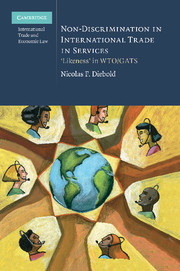Book contents
- Frontmatter
- Contents
- Foreword
- Acknowledgements
- Abbreviations
- List of Cases
- List of Legal Texts
- List of Documents
- Introduction
- PART I Foundations
- PART II Framing the conceptual breadth of ‘likeness’ in GATS
- PART III GATS specific ‘likeness’ issues
- PART IV Methodology for the ‘likeness’ analysis in GATS
- 13 The border tax adjustments framework
- 14 Applying market definition theories to ‘likeness’
- 15 The PPM-problem in the GATS ‘likeness’ context
- 16 Concluding summary: substitutability framework
- Summary of conclusions
- Bibliography
- Index
13 - The border tax adjustments framework
Published online by Cambridge University Press: 10 January 2011
- Frontmatter
- Contents
- Foreword
- Acknowledgements
- Abbreviations
- List of Cases
- List of Legal Texts
- List of Documents
- Introduction
- PART I Foundations
- PART II Framing the conceptual breadth of ‘likeness’ in GATS
- PART III GATS specific ‘likeness’ issues
- PART IV Methodology for the ‘likeness’ analysis in GATS
- 13 The border tax adjustments framework
- 14 Applying market definition theories to ‘likeness’
- 15 The PPM-problem in the GATS ‘likeness’ context
- 16 Concluding summary: substitutability framework
- Summary of conclusions
- Bibliography
- Index
Summary
The most intuitive approach to the ‘likeness’ issue in GATS is to apply the Border Tax Adjustments framework developed by GATT/WTO jurisprudence for purposes of the GATT ‘like products’ concept. This framework received its name from the Working Party Report on Border Tax Adjustments, adopted by the contracting parties in 1970, which developed three of the four criteria for the determination of ‘like products’:
‘With regard to the interpretation of the term “like or similar products”, which occurs some sixteen times throughout the General Agreement, it was recalled that considerable discussion had taken place … but that no further improvement of the term had been achieved. The Working Party concluded that problems arising from the interpretation of the terms should be examined on a case-by-case basis. This would allow a fair assessment in each case of the different elements that constitute a “similar” product. Some criteria were suggested for determining, on a case-by-case basis, whether a product is “similar”: the product's end-uses in a given market; consumers’ tastes and habits, which change from country to country; the product's properties, nature and quality.'
In addition to the three factors of physical characteristics, end-uses and consumers' tastes and habits, GATT 1947 practice recognized – nota bene already prior to the Border Tax Adjustments report – the uniform classification in tariff nomenclatures as a factor in the ‘likeness’ analysis.
- Type
- Chapter
- Information
- Non-Discrimination in International Trade in Services‘Likeness' in WTO/GATS, pp. 245 - 268Publisher: Cambridge University PressPrint publication year: 2010



